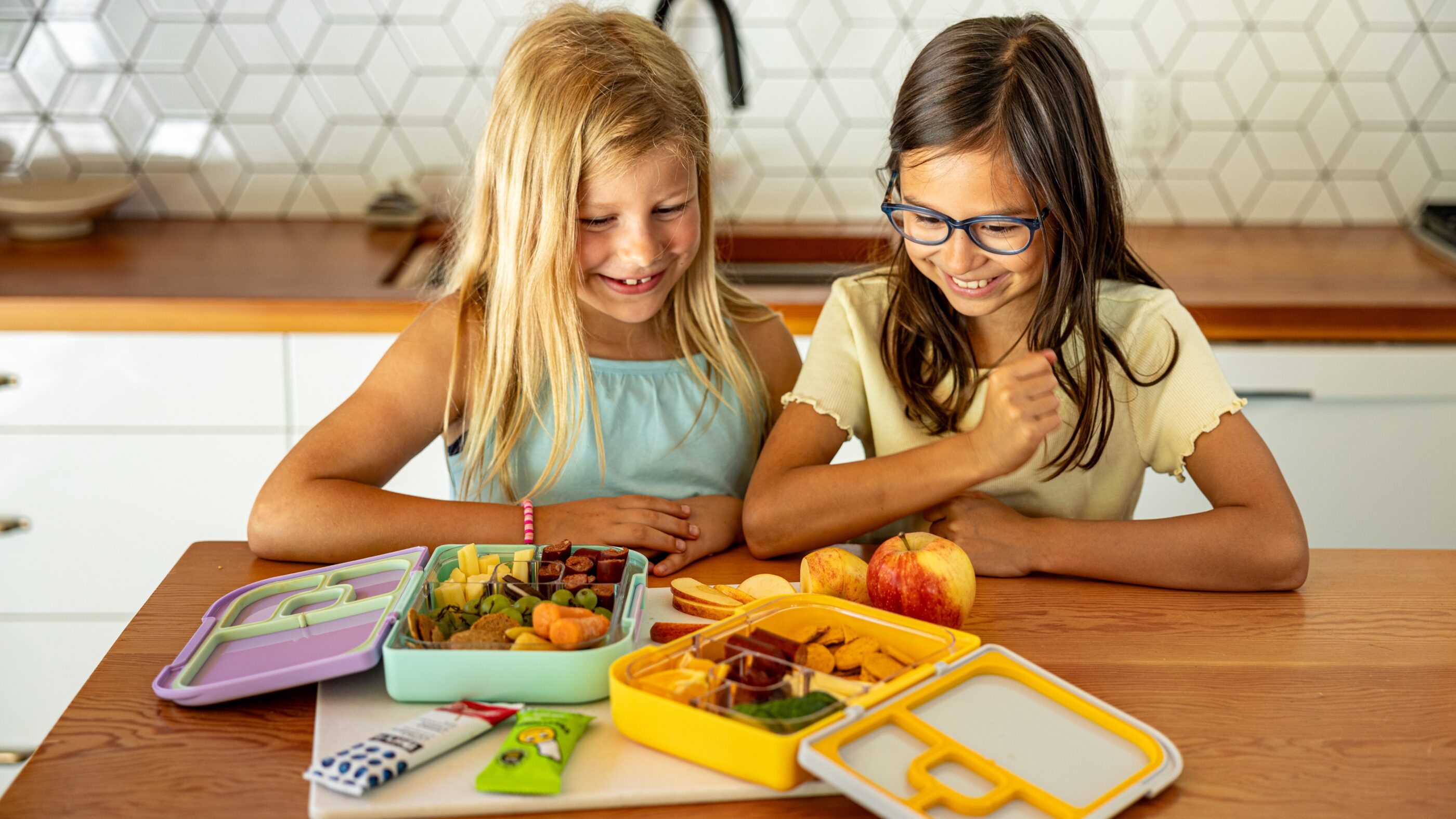The holidays are a time for family, food, and fun—but let’s be real, they can…
Ready or not, back-to-school time is upon us and lunch-packing is in our near future. I know that this isn’t likely your most treasured parenting task (ahem, same here!), but as a dietitian mom, I have compiled a collection of nourishing, school-safe and yummy lunch ideas for you, along with lots of tips and hacks to make lunch packing easier. Let’s do this!
Why school lunches are important
Even though packing school lunches can feel like a drag, this mid-day meal is one the of most important eating occasions in your child’s day. Packed lunches not only provide the bulk of our child’s nourishment at school, but they also provide an opportunity to introduce a variety of foods (both new and familiar) in simple and fun ways.
Speaking of fun, remember when you were a child and you were excited to open your lunch box because you knew there were foods in there that you liked? Building a lunchbox at home allows for customization, taking into account your child’s preferences and specific dietary needs (i.e. intolerances, allergies and cultural heritage).
A satisfied tummy at lunchtime not only improves blood sugar regulation and mood, it also allows for better concentration and learning in class. As I’m sure you know, it can feel impossible to focus on an empty stomach. Plus, our kids are growing and developing which means they need enough energy, protein and a variety of vitamins and minerals (such as iron, calcium, vitamin D, zinc, vitamin A, vitamin C, B vitamins, Omega 3s and more!) from the foods in their lunch.
But what if your child often brings home their lunch half-eaten or hardly touched? Luckily, I have realistic strategies you can try when packing lunch for your “picky” or selective eater.
Building school lunches for selective eaters
Most children and toddlers go through phases of “pickiness” or more pronounced selectivity when trying new foods. A common one is only wanting to eat “beige foods” like pasta, crackers, and bread, with little motivation to try other foods that often return home in their lunch box. Honestly, this is pretty typical. If this sounds familiar, here are 3 tried-and-true lunch box strategies that will help your kids try new foods, and eventually expand their “safe” food list:
1.Start slow—introduce new foods gradually!
Add a small portion of a new food to your child’s lunch, alongside familiar or “safe” food. This helps your child feel less pressure, and makes the new food appear less intimidating! Make sure to introduce only one new food at a time, and aim to present it in an appealing way. Include cute little plastic food picks in your child’s lunch box so they can skewer the new food without having to touch it. Another idea is to cut fun shapes using cookie cutters or place the food in a colourful muffin wrapper to make it more visually enticing!
2. Fill their autonomy bucket—include them in planning and ordering groceries!
Letting kids choose some of the items they want in their lunchboxes will help fill their ever-growing need for independence and autonomy. You can involve them in the planning of their lunch by asking them to help you build an online grocery list for the week ahead, or for little ones giving them a structured choice between 2 or 3 items to add in. The experience of helping plan their lunch helps to strengthen their food knowledge, nourishes family connection, and fuels their excitement about eating what they helped pack!
3. Facilitate food exploration—involve your child in packing their lunch box!
Ask your child to help chop, assemble and pack their lunch boxes the night before. Using their sense to touch, smell, and taste parts of their lunch meal ahead of time, facilitates sensory exploration of the food they will be enjoying at their next lunch meal. Pressure-free exploration of food (with the absence of pressure to eat it) helps cautious eaters open up to new foods!
All of these strategies help to reduce food waste with fewer uneaten lunches. Win-win!
How to Build a Nourishing Lunch Box
Packing your child’s lunch doesn’t have to be daunting – I’ve developed a really simple system that can help to make things easier—just fill it with 4 key components! You can even dive deeper into more tips for packing lunches.
Veggies and Fruit for Color
Fresh, frozen or canned (in water or their own juice) fruits and vegetables provide color, antioxidants, fibre, and essential vitamins (Vitamin A and C) that your child needs! These nutrients help strengthen their immune system to fight off viruses and recover from illness, as well as promote healthy digestion. Vegetables and fruit provide your child with energy (from carbohydrate) as well, however, they also require more carbohydrate-rich foods (what I call “starchy foods”) in their lunch box as well!
Starchy Foods for Energy
Starchy foods like rice, pasta, bread, potatoes, tortillas etc. provide a rich source of carbohydrate (the body’s preferred source of energy) for your child’s rapidly changing body and brain! Whether you choose to add whole grain products or not, they BOTH provide energy and essential nutrients! In Canada, all wheat flour (white or whole grain) is fortified with essential nutrients like iron and B vitamins which are key for energy production, healthy red blood cells, and brain development. Whole grain products retain goodness from all components of the grain, contributing a bit more dietary fibre and essential minerals like zinc and magnesium.
Protein Foods for Satisfaction
Protein foods (such as meat, chicken, fish, eggs, cheese, yogurt, nuts/seeds, tofu, beans and lentils) give our kids the building blocks they need for growth and repair of their body’s tissues, organs, and muscles. Protein also digests more slowly allowing for better blood sugar regulation, while also helping kids to feel full and satisfied for longer. This helps to improve mood and put them in a better mindset for learning!
Snack foods for Fun!
Don’t skip the snacks to fill in the gaps (between meals)! See what I did there? Snacks are a great way to include both new and familiar foods that are enticing and yummy. Things like homemade muffins, granola bars, trail mix (mix of dried fruits, seeds and chocolate chips), yogurt cups, cheese sticks, homemade banana bread, hummus and crackers, etc! The options are endless. I also like to recommend adding a sweet or savoury “treat” for fun – this makes opening their lunchbox exciting. Some ideas include mini chocolate bars, gummy worms, a brownie, cookies, mini cupcakes, chips, and popcorn. You get it!
Tips to Reduce Food Waste
Shopping sustainably, and reducing food waste is not always top of mind in a busy household. The good news is, that a few simple changes to how you plan, purchase, prepare and pack your family’s meals can make a big difference. Here are some easy ways to help improve your food footprint:
- Choose seasonal, local produce (when possible)– This type of produce is often more flavourful and travels less distance helping to reduce food waste. Why? Because it is fresh, will last longer, and often tastes better!
- Buy in bulk– Bulk foods are often also cheaper and involve less packaging of individually wrapped items, lowering waste and improving overall environmental sustainability.
- Take stock of what’s in your fridge and freezer first – Before heading to the store, check your fridge and freezer to see what needs to be used up. This helps you plan meals around what you already have, reducing the likelihood of forgotten items going to waste.
- Plan and shop for groceries online using Spud – Support the mission to create a safe and sustainable food ecosystem; Spud uses environmentally friendly delivery methods distributing local products, and produce to help support sustainable farming practices. The commitment to careful inventory management, reducing excess product stock and offering imperfect produce to customers helps to minimize food waste.
Let’s be honest, ordering groceries from the comfort of your home will save you both time and money allowing for more intentional grocery purchases with fewer impulse buys. Trust me, I’ve been there!
- Invest in reusable containers and eco-friendly food packaging– such as this abeego reuseable bees wax food wrap and this reusable Hugger Bag to store food instead of conventional single use plastic ones.
25 Nourishing & Kid-Approved Lunchbox Ideas
As promised, let’s get to the good stuff! You can find all of the ingredients needed in this handy grocery list. Happy shopping!
1.DIY Mini Pita Pizzas
Whole grain pita, tomato sauce, cheese, veggie toppings.
2. Chicken & Veggie Skewers
Grilled chicken pieces, cherry tomatoes, cucumber slices.
3. Build Your Own Greek Yogurt Parfait
Greek yogurt, granola, chia seeds, hemp hearts, fresh or frozen berries, sliced banana, mini chocolate chips, etc.
4. Mac and Cheese Cups + Veggie Sticks
Leftover mac and cheese baked in muffin tins, served with veggies sticks on the side. Serve with a fruit, granola bar or some trail mix.
5. Waffle Strips with Yogurt Dip
Whole grain waffles cut into strips, served with a side of Greek yogurt mixed with honey or maple syrup for dipping. Serve with fruit.
6. Charcuterie-style Lunch
Sliced deli meats, cheese, whole grain crackers, grapes, apple slices, and pickle slices etc.
7. Pizza Roll-Ups
Whole wheat tortillas, tomato sauce, cheese, and pepperoni slices, rolled up and sliced into pinwheels.
8. Rotisserie Chicken Lettuce Wraps
Shredded rotisserie chicken mixed with mayo and dried cranberries, butter lettuce leaves, shredded carrots, and a side of dressing or dip. Include a granola bar and crackers on the side.
9. Egg Bites and Apple Slices
Mini egg bites or muffins, apple slices with a side of nut butter or yogurt for dipping.
10. Salmon Salad Walnut Wrap
Canned or leftover flaked salmon mixed with mayo, chopped celery, and chopped walnuts, wrapped in a whole wheat tortilla with baby spinach or crunchy lettuce.
11. Banana Roll-up with Veggie Sticks
Whole wheat tortilla spread with school-safe seed butter, wrapped around a banana, served with carrot and cucumber sticks and dip.
12. Classic PB&J Waffle Sandwich (using nut-free seed butter)
Two waffles sandwiched with seed butter and jelly, cut into quarters for easy eating Serve with fresh chopped fruit and veggies.
13. Turkey-Cuke Roll-Ups and Mini Muffins
Slices of deli turkey meat wrapped around chopped cucumber sticks, with a side of mini muffins and fruit.
14. Baked Oatmeal Cups with Yogurt
Homemade baked oatmeal cups, served with a side of Greek yogurt and fresh fruit.
15. Left Over Penne Pasta with Meat Sauce and Shredded Cheese
Serve Penne Pasta and Meat Sauce mixed together or separate (whatever your child prefers), with a side of shredded cheese for them to sprinkle on top or eat separately. Include frozen peas on the side and a granola bar to round it out!
16. Create Your Own Croissant
Mini croissants with a variety of fillings like ham, turkey or leftover meat slices, cheese, and sliced veggies and dip for your child to assemble or eat separately.
17. Build Your Own Sliders
Mini slider buns, mini burger patties or leftover shredded BBQ chicken, cheese slices, lettuce, and tomato, and small container of ketchup or BBQ sauce for your child to build their own mini sliders.
18. Circle-Themed Lunch
Pack your child’s lunch with only circle-shaped foods. Get them involved in the planning! Examples: baby tomatoes, dry cheerios, homemade cookies, Babybel cheese, cucumber slices, grapes, chocolate chips, hard-boiled eggs, cored apple slices cut to look like “apple rings,” etc.
19. Mini Bagel Sandwiches
Mini bagels with cream cheese and turkey, or almond butter and banana slices. Serve with veggies and an individual yogurt cup!
20. Leftover Pizza Strips + Veggies and Dip
Strips of leftover pizza served with a side of veggie sticks and dip.
21. Mini Pita Pockets + Fruit
Whole wheat mini pita pockets filled with hummus and veggies. Option to add shredded rotisserie chicken to the pita for more protein! Serve with a banana or other favorite fruit or fruit bar.
22. Chia Pudding + Homemade Muffin + Fruit
Chia pudding made with milk of your choice, yogurt, and a touch of maple syrup. Add a yummy homemade muffin and a side of fresh fruit. Include some veggies sticks and hummus on the side as an option.
23. Mini Quesadilla Triangles with Salsa
Whole wheat tortillas filled with cheese and beans (optional), cut into triangles, served with a side of salsa and guacamole for dipping.
24. Build Your Own Taco Salad
Layer taco night leftovers with lettuce, tomatoes, cheese, and tortilla chips, served with salsa and sour cream on the side.
25. Chicken Caesar Salad (or Caesar salad wrap!)
Combine shredded chicken, romaine lettuce, croutons, and Parmesan cheese, with Caesar dressing on the side. Add a flour tortilla to make it into a wrap!
Meet Sarah
 Sarah Remmer, is a registered dietitian (since 2006) mom of 3 and the proud founder and President of The Centre for Family Nutrition, a Calgary-based nutrition counseling practice that specializes in prenatal, infant and child nutrition, that specializes in prenatal, infant and child nutrition.
Sarah Remmer, is a registered dietitian (since 2006) mom of 3 and the proud founder and President of The Centre for Family Nutrition, a Calgary-based nutrition counseling practice that specializes in prenatal, infant and child nutrition, that specializes in prenatal, infant and child nutrition.







